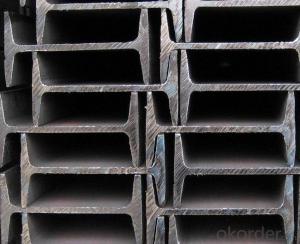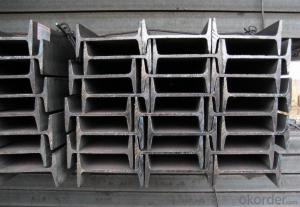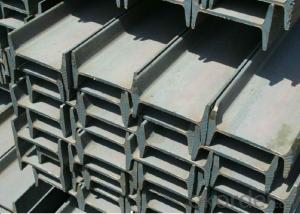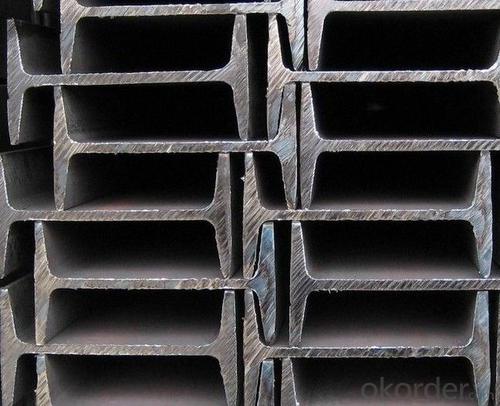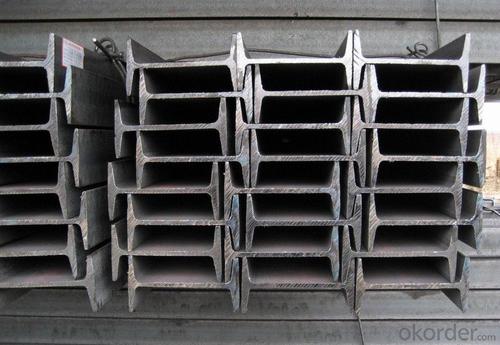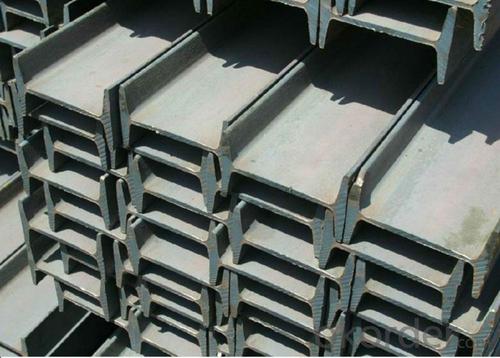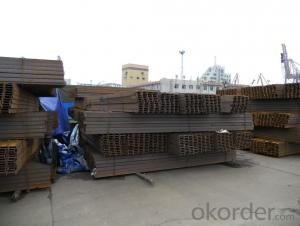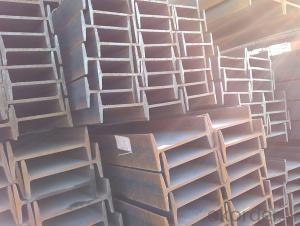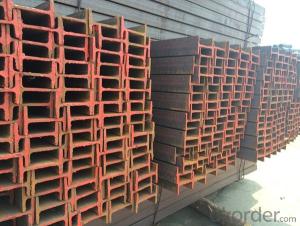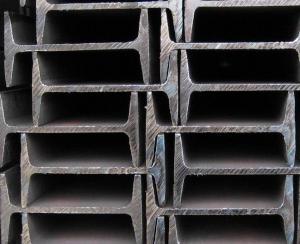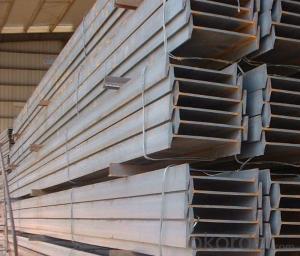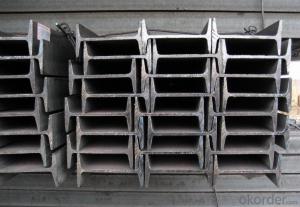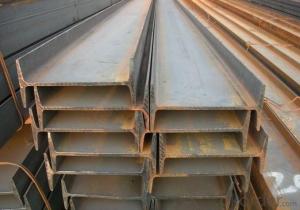IPE/IPEAA in European Standard with Grade Q235
- Loading Port:
- Tianjin
- Payment Terms:
- TT OR LC
- Min Order Qty:
- 25 m.t
- Supply Capability:
- 10000 m.t/month
OKorder Service Pledge
OKorder Financial Service
You Might Also Like
Product Description:
OKorder is offering high quality Hot Rolled Steel I-Beams at great prices with worldwide shipping. Our supplier is a world-class manufacturer of steel, with our products utilized the world over. OKorder annually supplies products to European, North American and Asian markets. We provide quotations within 24 hours of receiving an inquiry and guarantee competitive prices.
Product Applications:
1. Supporting members, most commonly in the house raising industry to strengthen timber bears under houses. Transmission line towers, etc
2. Prefabricated structure
3. Medium scale bridges
4. It is widely used in various building structures and engineering structures such as roof beams, bridges, transmission towers, hoisting machinery and transport machinery, ships, industrial furnaces, reaction tower, container frame and warehouse etc.
Product Advantages:
OKorder's Steel I-Beams are durable, strong, and resist corrosion.
Main Product Features:
· Premium quality
· Prompt delivery & seaworthy packing (30 days after receiving deposit)
· Corrosion resistance
· Can be recycled and reused
· Mill test certification
· Professional Service
· Competitive pricing
Product Specifications:
1. Invoicing on theoretical weight or actual weight as customer request
2. Standard: EN10025, GB Standard, ASTM
3. Grade: Q235B, Q345B, SS400, ASTM A36, S235JR, S275JR
4. Length: 5.8M, 6M, 9M, 12M as following table
5. Sizes: 80mm-270mm
Dimensions(mm) | |||||
h | b | s | t | Mass Kg/m | |
IPE80 | 80 | 46 | 3.80 | 5.20 | 6.00 |
IPE100 | 100 | 55 | 4.10 | 5.70 | 8.10 |
IPE120 | 120 | 64 | 4.80 | 6.30 | 10.40 |
IPE140 | 140 | 73 | 4.70 | 6.90 | 12.90 |
IPE160 | 160 | 82 | 5.00 | 7.40 | 15.80 |
IPE180 | 180 | 91 | 5.30 | 8.00 | 18.80 |
IPE200 | 200 | 100 | 5.60 | 8.50 | 22.40 |
IPE220 | 220 | 110 | 5.90 | 9.20 | 26.20 |
IPE240 | 240 | 120 | 6.20 | 9.80 | 30.70 |
IPE270 | 270 | 135 | 6.60 | 10.20 | 36.10 |
FAQ:
Q1: Why buy Materials & Equipment from OKorder.com?
A1: All products offered byOKorder.com are carefully selected from China's most reliable manufacturing enterprises. Through its ISO certifications, OKorder.com adheres to the highest standards and a commitment to supply chain safety and customer satisfaction.
Q2: How do we guarantee the quality of our products?
A2: We have established an advanced quality management system which conducts strict quality tests at every step, from raw materials to the final product. At the same time, we provide extensive follow-up service assurances as required.
Q3: The products are invoicing on theoritical weight or on actual weight?
A3: We can do it in both manners, according to the customers' request.
Images:
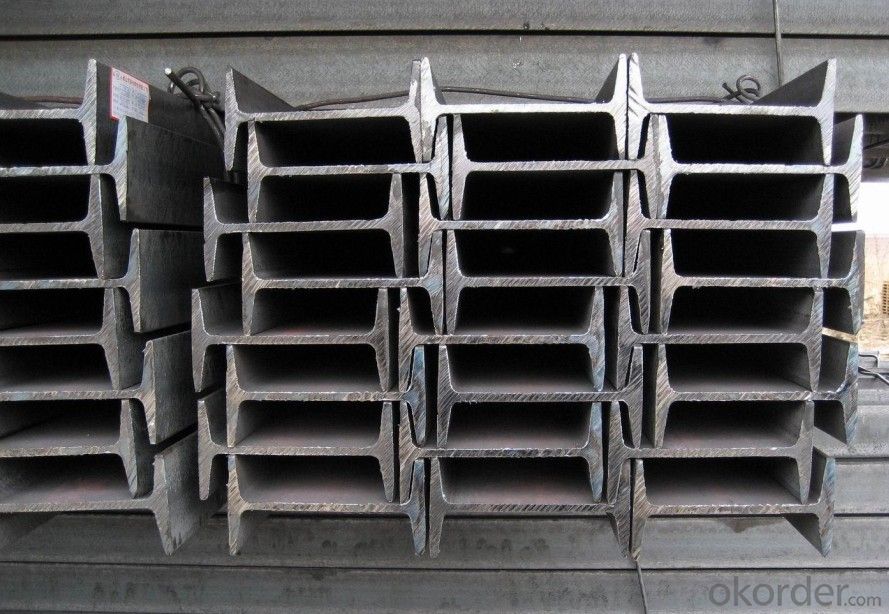
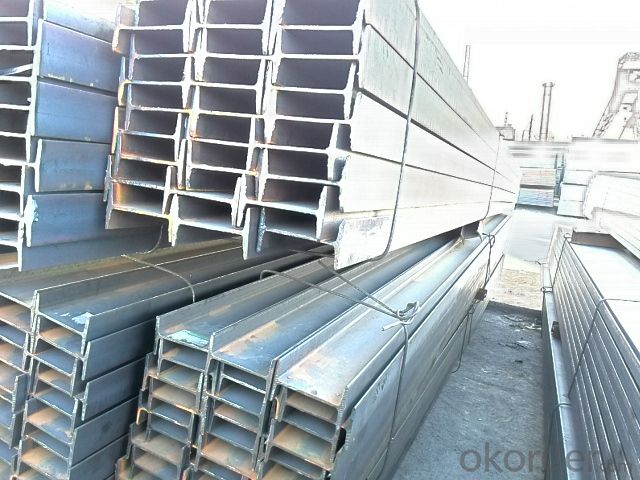
- Q: Channel and I-beam are commonly used in construction sites. It is better to have on-site construction drawings, thank you
- The picture is not good, and the I-beam is generally used for erection of overhanging scaffold. Channel steel, it can be made of steel beams and steel staircase structure, but also can do wall keel
- Q: Can steel I-beams be used in retail or commercial renovation projects?
- Certainly, steel I-beams are suitable for utilization in retail or commercial renovation ventures. Renowned for their robustness and durability, steel I-beams are an ideal choice for supporting hefty loads and ensuring structural stability. In the context of retail or commercial renovation, these steel I-beams can be employed to establish open and flexible floor plans, bolster mezzanine levels, fortify existing structures, or even erect new structures. Moreover, they can be effectively utilized to construct expansive windows or atriums, as they possess exceptional load-bearing capacities. Furthermore, the fire resistance and resilience to pests and decay exhibited by steel I-beams often render them the preferred option in renovation undertakings. All in all, steel I-beams are extensively favored in retail or commercial renovation projects due to their versatility, strength, and ability to endure the rigors of heavy usage.
- Q: Can steel I-beams be used to create mezzanine floors?
- Certainly, mezzanine floors can indeed be created using steel I-beams. These intermediate floors, which are typically inserted between the primary floors of a building, serve to generate extra usable space. The construction industry frequently employs steel I-beams owing to their robustness, longevity, and capacity to bear substantial loads. Given their ability to provide the requisite structural reinforcement necessary for supporting the added weight and ensuring the structure's safety, steel I-beams are highly suitable for fabricating mezzanine floors. Moreover, they can be tailored to suit the precise dimensions and specifications of the mezzanine floor, rendering them an adaptable and efficient choice for this particular application.
- Q: What is the supply length of 30# I-beam?
- 30# I-beam is only 12 meters, divided into 2 models. 30#A size 300*126*930#b size 300*128*1130# I-beam no C, no 30#C mills are upstairs. I am a Xi'an 30#A section of the national standard 30#B, 2020 yuan (including tax), a national standard of 2220 yuan (including tax)
- Q: How do steel I-beams contribute to the overall architectural design of a building?
- Steel I-beams are an essential component of architectural design as they provide structural support and stability to buildings. They allow for large, open floor plans and long spans between columns, enabling architects to create expansive, unobstructed spaces. Additionally, their strength and durability allow for the construction of taller buildings and the incorporation of unique design elements such as cantilevers and soaring ceilings. Overall, steel I-beams play a crucial role in shaping the architectural aesthetic and functionality of modern buildings.
- Q: Can steel I-beams be used in mezzanine floor construction?
- Yes, steel I-beams can be used in mezzanine floor construction. They are commonly used as the primary structural support for mezzanine floors due to their strength and durability. I-beams provide the necessary load-bearing capacity to support the additional weight of the mezzanine floor, making them an ideal choice for such construction.
- Q: Excuse me: how to use the steel joist to build the attic and the I-beam to go deep into the load-bearing wall. How many centimeters? Do we need to weld the main reinforcement?
- Reinforced concrete cast-in-place. Reinforced cement belongs to the practice of civil procedure, but there are additional conditions, there is the original wall plate is connected with the interface structure of steel bar or other fasteners, otherwise the weight of reinforced concrete is not generally a support or fixing piece can be fixed, maybe there will be a security threat. The advantages of reinforced concrete floor is when people walk on it, generally do not shake what sense, nor what sound (unless the floor is very thin, the disadvantage is that the cement floor) is very time-consuming, pouring good, pure maintenance time will be more than a month, the construction time and in front of the 2 months.
- Q: What is the length of common I-beam?
- The length of the steel bar is generally 9m and 12m; the length of the I-beam and H section steel is generally 12m; the factory length of the angle steel is generally 6 meters; the common length of the channel steel is 6 meters, /8 meters and /9 meters.
- Q: What are the common design considerations for steel I-beams in high-rise buildings?
- Some common design considerations for steel I-beams in high-rise buildings include the load-bearing capacity, structural stability, fire resistance, and overall cost-effectiveness. The I-beams need to be able to support the weight of the building and its occupants, while also withstanding potential lateral forces such as wind or earthquakes. Fire resistance is crucial to ensure the safety of the building, and cost-effectiveness is important to optimize the construction process. Additionally, factors like material quality, fabrication techniques, and connections between beams are also important considerations in the design process.
- Q: What are the different types of steel surface treatments available for I-beams?
- There are several types of steel surface treatments available for I-beams, each offering unique benefits and applications. 1. Hot-dip galvanizing: This is a widely used method where the I-beam is dipped into a bath of molten zinc. The zinc coating provides excellent corrosion resistance, making it suitable for outdoor applications. It also provides a barrier against moisture and physical damage. 2. Powder coating: It involves applying a dry powder to the I-beam's surface, which is then heated and cured to create a durable and decorative finish. Powder coating offers a wide range of colors and textures, making it popular for architectural and aesthetic purposes. 3. Epoxy coating: This is a two-part coating system that consists of a resin and a hardener. It provides excellent chemical resistance and protection against corrosion. Epoxy coatings are commonly used in industrial settings where the I-beams may come into contact with chemicals or harsh environments. 4. Paint coating: This is a traditional method where paint is applied to the surface of the I-beam. It provides some level of protection against corrosion but is generally less durable compared to other surface treatments. Paint coatings are often used for indoor applications or when aesthetics are a priority. 5. Shot blasting: This is a mechanical surface treatment where small steel shots are propelled at high speeds to remove rust, scale, and other contaminants from the I-beam's surface. Shot blasting creates a clean and rough surface, allowing for better adhesion of subsequent coatings or paints. It is important to consider the specific requirements and environmental conditions when choosing a steel surface treatment for I-beams. Consulting with a professional or a steel manufacturer can help determine the most suitable treatment for a particular application.
Send your message to us
IPE/IPEAA in European Standard with Grade Q235
- Loading Port:
- Tianjin
- Payment Terms:
- TT OR LC
- Min Order Qty:
- 25 m.t
- Supply Capability:
- 10000 m.t/month
OKorder Service Pledge
OKorder Financial Service
Similar products
Hot products
Hot Searches
Related keywords
